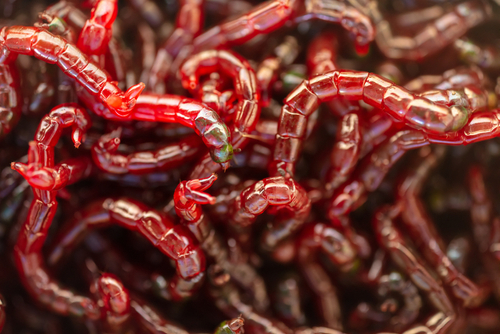In the wild, fish keep healthy by feeding on lower life forms at sea or in the water habitat. These food types include zooplankton, other fish, and worms.
When they become pet fish, you want to keep your fish healthy by mimicking their diet in the wild. Several fish feed pellets are available in pet stores, but you keep your fish healthy when you feed your fish with a wide-ranging diet.
Frozen worms are a favorite snack in the tank, and most fish love to eat bloodworms. This is just the article for you if you are a new fish parent or want to improve your fish’s pallet. This article will discuss bloodworms, their nutritional content, and why you should include live bloodworms and frozen blocks of these goodies in your fish’s diet.
Let’s go!
Contents
What Are Bloodworms?
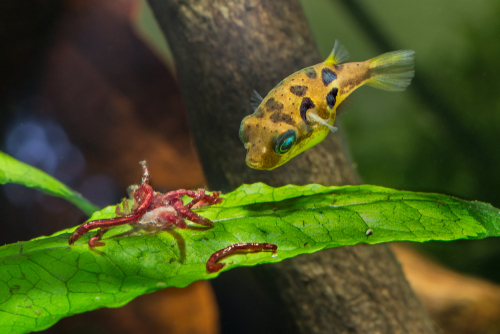
Bloodworms should not be strangers to you if you are a goldfish parent or a frequent visitor at a freshwater fish pond. But if you are not in any of the above categories, you may wonder what bloodworms are.
Unlike your first perception of their name, bloodworms do not feed on blood. Instead, they get their name from their bright red color. Bloodworms are larvae of non-biting midge flies that will eventually develop into flies.
Although different worms have the general name of “bloodworms,” you can always distinguish them by their vivid red color. In shallow waters, you can find a group of bristle worms with the Latin name Glycera dibranchiata. Because of the iron-porphyrin protein in their blood and tissue, bloodworms have an intense red color.
Since bloodworms are essentially at the bottom of the aquatic food chain, most fish would consume them if given a chance. Bloodworms are regular proteins used to feed pet fish, but frogs, crabs, shrimp, snails, salamanders, and turtles like them.
Where do you find Bloodworms?
You can find these bloodworms in the soft soil around freshwater bodies. This makes them an easy part of the aquatic food chain as they provide essential amino acids for fish. Most people use bloodworms as fish bait and others as fish food.
Bloodworms are regular staples in pet stores, and you can buy frozen or freeze-dried bloodworms. You can also start a bloodworm farm where you own bloodworms and sell the gelatinous egg sacs or as live foods to fish keepers.
Breeding bloodworms is a whole process, but it can be a food source for mass-feeding large and small fish farms. Of course, there are other protein sources for pet fish and fish in the wild. These include adult flies, midge flies, and shrimp. These have their peculiarities, and the biting midge flies are most famous for painful bites.
Some carnivorous fish in the wild subsist on live worms and other aquatic animals. You can mimic their behavior in the wild and activate their hunting instincts by feeding your fish with live bloodworms as a tasty treat. Many fish in captivity enjoy bloodworms as snacks or meals.
Other live protein sources for fish include ghost shrimp, Amano shrimp, African cichlids, and other smaller fish. The live protein source you choose for your fish depends on the size of your fish. This is because you do not want your fish to become prey to the live feed you introduce to your fish tank.
Don’t miss:
Bloodworms –Types
If you have been a fish parent or enthusiast for a while, you have probably heard about bloodworms and the various ways you may purchase them. The multiple forms of bloodworms each have benefits, depending on your use. You can buy freeze dried, frozen, or bloodworms in live condition. Here is a little about each form of bloodworm:
1. Freeze Dried Bloodworms
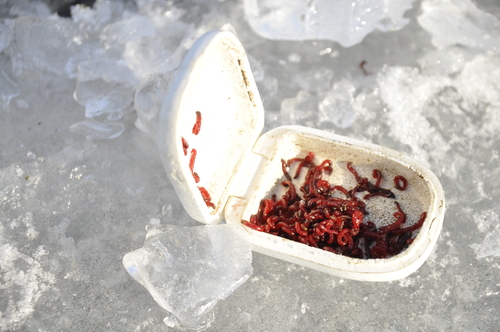
If you are looking for a stress-free way to include bloodworms in your fish food, freeze-dried bloodworms are a fantastic alternative. You can easily control the portions you deliver because they do not need to be prepared or defrosted. Freeze-dried bloodworms are an affordable option if you wish to buy them.
Be sure to check the label of the bloodworms you are purchasing because several quality categories of freeze-dried bloodworms are available. The low-cost alternative may seem appealing. Yet, it may not offer any of the advantages associated with bloodworms. In this instance, buying a more expensive brand would probably be beneficial.
The least wholesome and nutrient-dense alternative for your fish is freeze dried bloodworm. These will not thrill your fish as live bloodworms. You probably will not notice any changes in their behavior as you may when you give them fresh ones. When you include bloodworms in your fish food, it triggers their hunting instincts and makes your fish very active.
2. Frozen Bloodworms
When you want to feed your fish bloodworms, another option to consider is bloodworms as frozen food. Fish parents often feed fish frozen bloodworms. Frozen bloodworm feed is efficient as it is easier to buy frozen bloodworm and store it. This is because you can pull out a portion to feed your aquarium fish whenever you need to. You can keep frozen bloodworms for up to 6 weeks and can feed your fish at comfortable intervals.
Freezing bloodworms reduces the possibility that they may become sick and infect your fish. This kind of bloodworm might be the one to choose if you have never fed your fish bloodworms before. This is because they do not need any preparation and will not likely make your fish sick.
Additionally, using frozen bloodworms allows you to have a bit more control over how much you feed your fish. Unlike live bloodworms, you can uniformly distribute frozen bloodworms throughout the aquarium. This will allow all of your fish to eat them.
3. Bloodworm Gel
Fish keepers also love gel-based fish food very much. Many fish are picky eaters and will not eat pellets and flakes. This is not ideal, especially since living foods are not always readily accessible. And this is precisely the situation when gel-based cuisine can save the day.
Bloodworm gels offer the vital proteins and vitamins that your carnivore fish require to flourish healthily in captivity and come in a variety of flavors, including bloodworms.
Making bloodworm gel food at home is also possible. You can do this by combining bloodworms with conventional gel food recipes. Although ideally, why not feed bloodworms directly if you can find them in their live form rather than turning them into a gel-based food?
4. Live Bloodworms
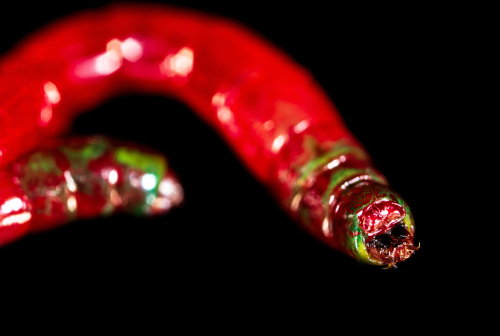
You can also choose to feed bloodworms live to your fish as part of the fish food. Some fish keepers purchase live bloodworms because they believe this is the most hygienic approach to feed their fish. This is somewhat true; fresh bloodworms are always preferable to defrosted food or freeze dried bloodworms.
Live bloodworms are higher in nutrition and vitamin-packed fish food than other forms. Feeding fish to live bloodworms will be beneficial to them. Live bloodworms are a great way to feed your fish with a nutrient-rich meal before breeding them if you plan to do so soon. It is also easier to pass live bloodworms through your fish-feeding cone.
There is constriction for fish in small plastic tubs, which causes the fish to be inactive. Feeding them bloodworms will revive their hunting instinct. Also, because bloodworms feed zooplankton, they keep these in check by eating algae in the fish tank.
Frozen or freeze-dried bloodworms might not have the same effect as live bloodworms in making your fish appear more active.
However, as you might have suspected, you cannot keep live bloodworms for long periods. After you buy them, you have around two to three days to feed live bloodworms to your fish before they expire. For this reason, although they are nutritious and stir up fish’s hunting instincts, people prefer frozen or freeze dried bloodworms to live worms.
Bloodworms –Their Uses
Bloodworms are famous as the ultimate fish bait for freshwater or saltwater fish or as food for aquarium fish because fish love them so much. They are extremely well-liked on the angler market because big predatory fish love their meaty texture.
Bloodworms are an excellent food source for fish in aquariums, depending on the size of your fish. You will only want 14-inch bloodworms that are mature if your fish are large. But you can use younger bloodworms in your fish tank as a source of a varied diet for your fish.
Fish can use bloodworms as a laxative. So if you suspect your fish may be constipated, giving them bloodworms will aid in the recovery of their digestive systems. However, if you attempt to treat their constipation by feeding the fish bloodworms daily, they can have regular constipation.
If you have picky fish and they refuse to eat regular feed, try feeding the fish bloodworms. Bloodworms might cheer up your fish if they do not seem to enjoy their feeding. Live bloodworms will create a flurry of movement in your fish tank as the fish struggle to eat bloodworms. These bloodworm snacks also provide nutrients, as the iron and protein they contain should give your fish an energy boost.
It does not matter if your fish eats live or frozen bloodworms. They will get high protein and vitamins from this meal.
Can You Use Bloodworms to Feed Betta Fish?
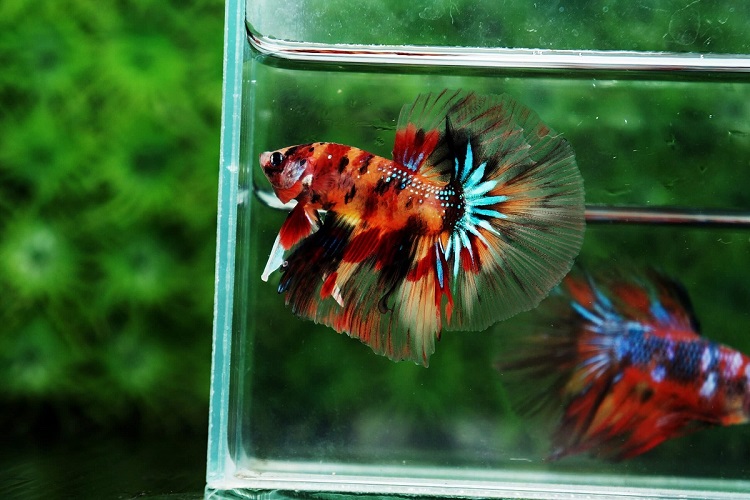
You need to know a few things before giving your betta fish bloodworms if you have some.
- Make sure to give bloodworms a little period in the water before adding them to the betta’s tank.
- After putting the worms in the tank, let them settle for a few minutes. If there are any leftovers, remove them right away.
- The pieces could start to decompose and increase the ammonia level in the water tank.
- Even after they are full, betta fish in your aquarium will continue to eat. So, you should not overfeed them as this could cause issues.
- To prevent constipation, limit your bloodworm intake to 1-2 each meal. Never drop a frozen cube in its entirety.
- You must also pay attention to how often you feed. Bloodworms are high in protein and fat, and your betta will have issues if you feed it too many of them. So, only give these fish bloodworms once or twice every week.
Breeding Conditions for Bloodworms
You might believe that raising bloodworms would be more affordable and practical than purchasing live ones.
You can reduce the odds of parasites and disease transmission by breeding your own bloodworms. You can also be sure of their breeding environment. However, most beginners find it difficult and impractical to breed them.
Unlike in fish breeding, growing bloodworms can be challenging because you need a location where they can fully develop into flies. This is because the flies are prone to flying off to lay their bloodworm eggs elsewhere.
You must also consider where to buy bloodworm eggs from. This is because infected bloodworm eggs can pass diseases to fish in your pond.
The bloodworm larvae life cycle has four basic stages: egg, larva, pupa, and adult midge. The biggest challenge is the inability to get midges to swarm and mate while they are in captivity.
The majority of hobbyists who raise their own worms use black worms or tubifex worms as parent stock for feeding fish.
You can try it if you are up for a challenge, but you won’t save much money if you don’t already have everything you need. Their natural habitat is freshwater ponds, so you will have to mimic this environment.
The simple part is growing bloodworms from their eggs. In a container with some soil and manure, maintain some chironomid eggs. Add some water, then keep it somewhere cool and dark.
If you add a little dung each week, the insect larvae will eventually hatch from the eggs. To feed your fish, you can use a net to capture these.
The tricky part is producing additional bloodworms in breeding. For some bloodworms to mature into adult midges and swarm to lay new eggs, you will need a space the size of a greenhouse. This is because once eggs hatch, they may be numerous and will need a large space to thrive.
Other Live Protein Sources for Fish

Here are some additional fish meal options in addition to bloodworms:
1. Brine Shrimp: A member of the Artemiidae family, brine shrimp are easy to care for in captivity and are a good source of vitamins, lipids, and amino acids. You can find these in shallow marine waters. So, there is always a live protein source for fish in the wild.
2. Ghost Shrimp: These freshwater animals give your fish the nutrition they need to thrive and maintain the aquarium tidy by removing and consuming algae.
3. Amano Shrimp: This protein source is a good alternative for beginning fish keepers because they provide food for many aquatic creatures and help you by eating algae.
Frequently Asked Questions
People also wanted to know:
Are bloodworms dangerous?
People often wonder if bloodworms bite. Yes, they can bite humans. This is the only real danger you have when handling this fish food. So, when using bloodworms as fishing bait, try to wear gloves. This will also help if you have bloodworm allergies.
How often should You Feed Bloodworms to Fish?
You can give your fish a tasty treat of bloodworms to eat once or twice weekly. But always remember to give your fish a varied diet. Constipation can result from giving bloodworms to your fish in excess.

Veteran fish keeper and keen hobbyist with a serious case of MTS. My midlife crisis was the establishment of a fish room, much to my wife’s horror. Little does she know it could be worse!!


